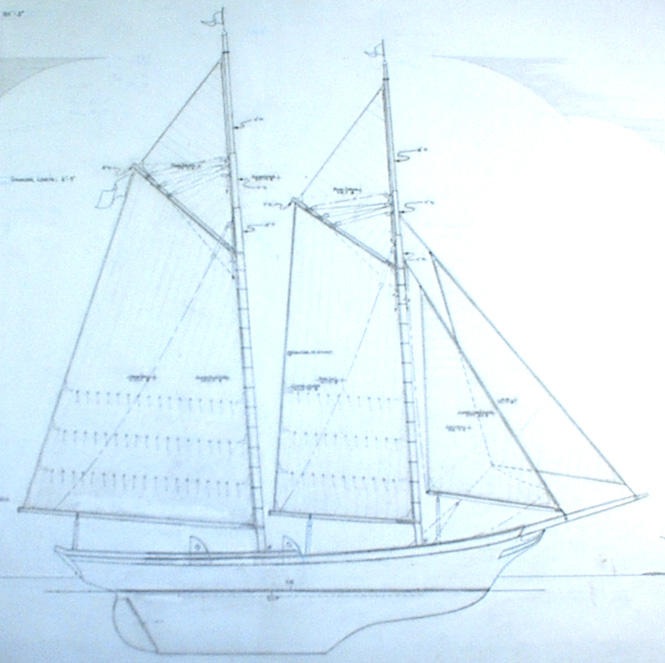 |
| The partially completed profile and rig for the Halie & Matthew 90 |
90' Clipper Bowed Gaff Rigged Schooner
for
Passenger Carrying in Downeast Maine
03/28/2002
 |
| The partially completed profile and rig for the Halie & Matthew 90 |
Accommodations
The schooner has 10 staterooms with en suite heads with showers. Each staterom has a
double berth plus provision for a pipe or root berth for one above it. The saloon is aft
of the mainmast and has a large skylight on an 18" high trunk above it. Aft of this
is the galley and crew's quarters, including a private double stateroom for the Cook and a
large stateroom with a double berth and two singles for the Captain and his family. This
also requires a low trunk. Otherwise the vessel is to be essentially flush decked. We will
try to accommodate up to 90 day passengers as well.
Rig
Rig is to be that of a double topsail gaff schooner on the pattern of the later
fishing schooners such as the Fredonia type. Steel masts are contemplated.
Some spars may conveniently be solid wood, hollow wood or aluminum. We would attempt to
judge this on the individual case and the building situation and crew capabilities. For
instance booms might profitably be solid wood as the weight is helpful in proper sail set.
Conversely the gaffs should be as light as possible to minimize sag off to leeward and the
resulting sail twist.
Lines
The lines are appropriate to the rig but modified from the traditional to give a
lighter less expensive vessel to build as is appropriate to the light "cargo".
The designer would prefer using outside lead ballast to make certification easier. This in
the form of cast lead pieces of the largest size that can be transported and maneuvered
into position. These have the advantage that they might be added after the rest of the
hull was built and transported near the water to keep the height low and weight down to an
amount transportable by a single large hydraulic trailer. Also the lead would protect the
structure of the boat from abrasion in hauling or grounding. However, the clients favor
inside ballast of lead resin. This is acceptable but to get the same degree of stability
has required careful attention to keel shape and structure. Great emphasis has been placed
on developing lines that would both be easy to get certified and seaworthy enough for
offshore use. Also a great deal of effort has gone into making sure the lines have the
best possible bias toward a very fast vessel as fast is always fun for the passengers and
makes it easier to get the best crew. At the time of this writing the lines are complete
and we are extremely pleased with them. w
Engines & Equipment
There was a good deal of discussion about whether to use a single diesel engine or two
for propulsion. Either was perfectly acceptable to the designer. Eventually this was
decided in favor of a single engine with a centerline shaft in a propeller aperture. The
designer recommends the Lunenburg schooner windlasses of appropriate size arranged to be
operated either manually or by hydraulics. In the galley we recommend the Dickinson
"Beaufort" diesel stove for cooking. In the heads we recommend the Raritan
"ElectraSan" sewage treatment systems for each pair of heads. This would
normally be combine with a holding tank for retention in the event that the vessel must
travel through a no-discharge area at some time in the future. For the actual water closet
we recommend the Raritan PHE II if you wish a head with electric flush capabilities but
wish to retain the manual pumping capability. For a more economical fully manual flush
system we recommend the Baby Blake heads.
Construction
Sheathed strip construction was recommended by the designer in light of the need for
this vessel to be easily built one off with the minimum wasted expense and labor and also
the minimum overall material and labor cost generally. Additionally sheathed strip
construction keeps the routine maintenance and repair expenses down as much as possible
which is a very important factor in profitability. However, the clients prefer
conventional solid fiberglass construction fully framed with glass hat section frames so
that is what we have gone with. All bulkheads will be structural. While this may be
somewhat more expensive in materials and requires more labor and therefore more expense
there is little doubt that it will produce a good solid vessel.
We will keep you posted on progress on this design as we can.